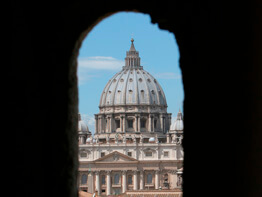VATICAN CITY – For the first time in a decade, summer tourists could make their way down steep stone steps deep into the dark, dank interior of a papal fortress and crawl into prison cells that housed countless common criminals as well as Rome’s errant elite.
The 1,900-year-old Castel Sant’Angelo, which stands near the Tiber River, was built as a mausoleum for the Emperor Hadrian, then was converted into a fortress by medieval popes.
At times, the turreted castle served as a refuge for beleaguered and besieged pontiffs and as a high-security prison.
While not wanting to justify the church’s past practice of imprisonment, torture and sometimes executions, one Vatican expert said it was important to remember that at the time “the papal state was a territorial state, so you had to take care of thieves and murderers who are put into prisons like in every state.”
The Vatican Museums’ Arnold Nesselrath, director of the Byzantine, medieval and modern collections, told Catholic News Service that, while the church’s large temporal jurisdiction “was probably wrong at every time of history, (its penal practice) was consistent with what was going on in other countries.”
Starting in the first century, the church wielded temporal power over shifting territories known as the Papal States across parts of modern-day Italy.
“Being a territorial state there were political problems, also. There were people who plotted against the pope,” Nesselrath said, and that “puts into difficulty a territorial sovereign.”
The pontiffs not only had foreign powers bent on invasion and rival Roman emperors to contend with, but infighting among powerful Roman families vying for control of the papacy was such a threat that the Roman Curia moved for safety to Avignon, France, in the early 1300s.
When the papacy moved back to Rome in the late 14th century, the pope still “had to re-establish his role, which was of course against the barons who did what they liked,” Nesselrath said. Internal divisions within the church worsened during the Reformation and Counter-Reformation, thus broadening the list of enemies of the church who risked imprisonment.
Prisons were scattered throughout the papal territories, but the one in Castel Sant’Angelo was unique.
Sometimes prisoners and the pope were holed up in the same fortress, especially during the mercenary army invasion of King Charles V in 1527 that led to the sack of Rome.
Several times during a period of “sede vacante” – when one pope had died and another had not yet been elected – large numbers of inmates were transferred from other prisons to Castel Sant’Angelo.
Miria Nardi, head of Castel Sant’Angelo’s library and archives, told CNS that the possibility for prison breaks was much greater during a “sede vacante,” when the power vacuum could lead to chaos or confusion. Therefore, exceptionally dangerous inmates were moved quickly to the castle because it was more secure.
Only five rooms were originally built to serve as prison cells in the early 1500s.
As the need for more cells arose, other rooms and spaces in the vast complex were converted into detention centers. Even tall grain silos inside the fortress were converted into jail cells.
The number of political prisoners in papal jails swelled during Italy’s Risorgimento in the 19th century when revolutionaries fought for the unification of Italy. Nardi said the number of prisoners varied constantly but that one document recorded 681 detainees in 1828.
Little is known about the conditions prisoners faced in this fortress prison. However, Nesselrath said since it was not built to be a prison but a tomb it was “probably the worst dungeon you can imagine.”
A former Castel Sant’Angelo inmate, the famed 16th-century Florentine artist, Benvenuto Cellini, wrote an autobiography describing the conditions he faced while in solitary confinement there.
Jailed on charges of murder, Cellini called his cell “a gloomy dungeon below the level of a garden, which swam with water and was full of big spiders and many venomous worms.”
He slept on “a wretched mattress of course hemp” which after three days “soaked up water like a sponge,” he wrote.
Cellini was incarcerated with a broken leg – an injury he sustained in a previous escape after climbing and jumping off the castle’s ramparts, using torn bed sheets sewn into long ropes.
Cellini’s fate was fortunate: His leg healed despite the neglect, and after a year of prison the pope exiled him to France.
Others, like members of Rome’s important Cenci family, died at the hands of papal executioners in the square in front of Castel Sant’Angelo.
Declared guilty of murdering Francesco Cenci, the dead nobleman’s daughter and second wife were decapitated in 1599 before a large crowd while one son was drawn and quartered.
In 1969, Pope Paul VI formally banned the use of the death penalty in Vatican City State, although no one had been executed under the authority of the Vatican’s temporal governance since 1870, when the Papal States dissolved after Rome and the surrounding territories were annexed to a unified Italy.
Nesselrath said more scholarly sleuthing needs to be done on papal prisons and punishment – which would certainly reveal there were “abuses and ways we don’t consider the right ones anymore today.”
But more research could be done by Vatican or church experts that puts the past “into a historical context,” he said, since a lot of the historical studies that exist take a “sort of traditional, very anti-Catholic approach.”


